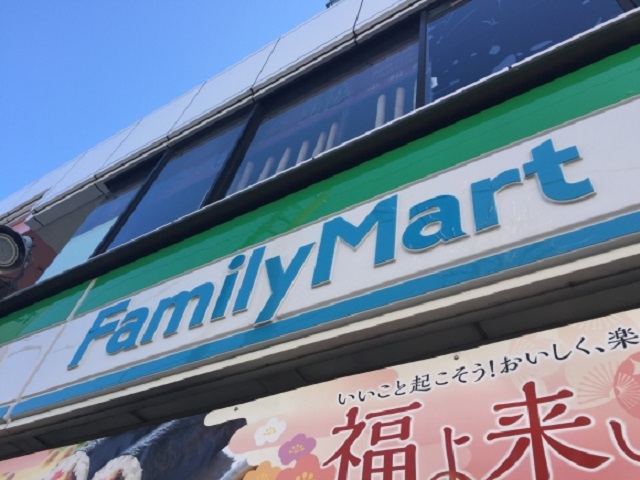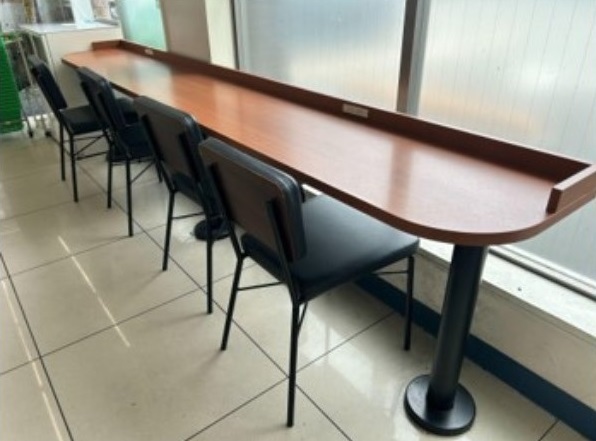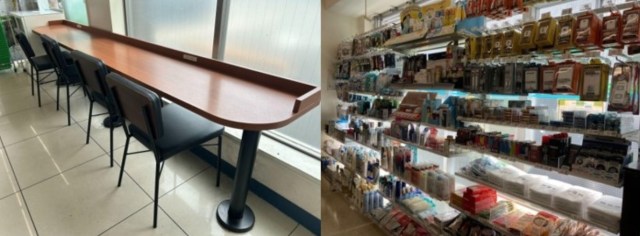
Goodbye eat-in spaces, hello more convenience store clothing?
There’s a lot of joy to be found in just randomly browsing through a Japanese convenience store, where the high-quality and uniqueness of the ever-changing lineup of food and drinks means there’s always a tasty surprise or two waiting for you. And as you round one aisle of shelves, you might have yet another surprise when you see tables or a counter with chairs. For example, here’s one inside a branch of Family Mart, one of Japan’s largest convenience store chains.
Called eat-in corners or eat-in spaces, they’re a testament to the high quality of Japanese convenience store offerings, showing that the food and drink is good enough to warrant sitting down and enjoying like you’re at a mini cafe. However, the eat-in space’s days are now numbered at Family Mart, who says they’re planning to get rid of them at branches nationwide.
Family Mart made a big push to add eat-in spaces to its shops in 2017, and currently you can find them in about 7,000 branches. However, Family Mart has announced that it will be converting the eat-in areas to sales floor space as part of its efforts to “meet diversifying customer needs.”
Now, as a retail business, when Family Mart says it wants to more effectively “meet customer needs,” that effectively means they want to increase sales, and in turn profits. According to Family Mart, the company has observed reduced usage of its eat-in spaces since the coronavirus pandemic, and feels that their floor space could be better used for stocking items from its clothing line, which it’s seeing expanding demand for, as well as non-food-and-drink daily essentials such as toilet paper and detergent.
▼ A before/after concept image from Family Mart
Something Family Mart doesn’t mention in its announcement, but which may be playing a part in lower usage of its stores’ eat-in spaces, is the way convenience store purchases are taxed. When you buy food or drinks at a Family Mart with an eat-in space, the clerk will often ask if you’re purchasing it to eat there or to take home. This isn’t because Family Mart is so fancy as to provide table service for its eat-in customers, though. It’s because sales tax in Japan for groceries and take-out food and drink items is 8 percent, but sales tax for food and drink consumed in a restaurant is 10 percent. In the eyes of the law, convenience store eat-in corners count as “restaurants” and carry the higher tax rate, the cost of which convenience stores pass on to their customers. In other words, if you’re buying something at Family Mart, it’s more expensive if you eat or drink it in-store, and less expensive if you instead have it back at your home or office, in the park, or even in the parking lot.
This wasn’t always the case, though. Both eat-in and take-out items were taxed at an identical 8 percent until October of 2019, and so reduced use of Family Mart’s eat-in spaces might not be so much a case of people having gotten used to not eating in-store during the pandemic as it is a case of customers saying “Yeah, I’d rather pay the cheaper of the two prices,” especially as consumer prices continue to rise and outpace income growth in Japan.
Family Mart says that some stores might retain their eat-in spaces, but the push to convert them to sales spaces will be taking place across the entire chain, with 2,000 eat-in spaces to disappear by the end of this year.
Source: Family Mart, IT Media via Yahoo! Japan News
Top image ©SoraNews24
Insert images: Family Mart
● Want to hear about SoraNews24’s latest articles as soon as they’re published? Follow us on Facebook and Twitter!



 Japanese convenience store Family Mart adding crane games to thousands of branches
Japanese convenience store Family Mart adding crane games to thousands of branches Coordinating a whole outfit with nothing but clothes from Japanese convenience store Family Mart
Coordinating a whole outfit with nothing but clothes from Japanese convenience store Family Mart Drinking sake just got more convenient with convenience store Family Mart’s new canned brews
Drinking sake just got more convenient with convenience store Family Mart’s new canned brews Japan’s Cat Day comes to Family Mart convenience stores with huge line of feline-fun sweets, drinks
Japan’s Cat Day comes to Family Mart convenience stores with huge line of feline-fun sweets, drinks The dream of all-you-can-eat Japanese convenience store fried chicken is now a reality
The dream of all-you-can-eat Japanese convenience store fried chicken is now a reality Hayao Miyazaki says Happy New Year to Studio Ghibli fans with new art for Year of the Horse
Hayao Miyazaki says Happy New Year to Studio Ghibli fans with new art for Year of the Horse That time Seiji called JASRAC to ask why he didn’t get paid royalties for his song being on TV
That time Seiji called JASRAC to ask why he didn’t get paid royalties for his song being on TV We revisited Sweets Paradise after a decade to see if Japan’s dessert buffet still delivers
We revisited Sweets Paradise after a decade to see if Japan’s dessert buffet still delivers Japan’s otoshidama tradition of giving kids money at New Year’s gets a social welfare upgrade
Japan’s otoshidama tradition of giving kids money at New Year’s gets a social welfare upgrade Japanese thug wear from Birth Japan perfect for those breaking bad next year
Japanese thug wear from Birth Japan perfect for those breaking bad next year Are all Starbucks coffee sizes the same? Testing the viral video claim in Japan
Are all Starbucks coffee sizes the same? Testing the viral video claim in Japan Awesome Japanese sandals give you the footprints of a cat or T-rex
Awesome Japanese sandals give you the footprints of a cat or T-rex Telecommute with Pikachu! Over 250 Pokémon video chat backgrounds now free to download
Telecommute with Pikachu! Over 250 Pokémon video chat backgrounds now free to download Toilet teaching – Japanese programmer explains key concept with clever bathroom snapshot
Toilet teaching – Japanese programmer explains key concept with clever bathroom snapshot We found possibly the quietest Japanese-style hotel in Tokyo’s bustling Shinjuku district
We found possibly the quietest Japanese-style hotel in Tokyo’s bustling Shinjuku district Starbucks Japan ready to get Year of the Horse started with adorable drinkware and plushies【Pics】
Starbucks Japan ready to get Year of the Horse started with adorable drinkware and plushies【Pics】 Cyberpunk anime meets traditional culture in Ghost in the Shell gold leaf Japanese changing screens
Cyberpunk anime meets traditional culture in Ghost in the Shell gold leaf Japanese changing screens 7 great places to see Mt. Fuji from without having to climb it
7 great places to see Mt. Fuji from without having to climb it Hello Kitty Choco Egg figures are an adorable trip through three periods of Japanese pop culture【Pics】
Hello Kitty Choco Egg figures are an adorable trip through three periods of Japanese pop culture【Pics】 7-Eleven Japan’s ramen-cooking robot whipped us up a bowl of noodles【Taste test】
7-Eleven Japan’s ramen-cooking robot whipped us up a bowl of noodles【Taste test】 Sumo Sanrio! Hello Kitty and pals team up with Japan Sumo Association for new merch【Pics】
Sumo Sanrio! Hello Kitty and pals team up with Japan Sumo Association for new merch【Pics】 More Than a Capsule Stay: Why Solo Travelers Choose “global cabin Yokohama Chinatown”
More Than a Capsule Stay: Why Solo Travelers Choose “global cabin Yokohama Chinatown” Japan’s oldest largetooth sawfish in captivity back on display in Mie Prefecture
Japan’s oldest largetooth sawfish in captivity back on display in Mie Prefecture 7-Eleven Japan starts new temporary luggage storage service in over 300 branches
7-Eleven Japan starts new temporary luggage storage service in over 300 branches Disillusionment at Tsukiji’s tourist-target prices led us to a great ramen restaurant in Tokyo
Disillusionment at Tsukiji’s tourist-target prices led us to a great ramen restaurant in Tokyo Starbucks teams up with 166-year-old Kyoto doll maker for Year of the Horse decorations【Photos】
Starbucks teams up with 166-year-old Kyoto doll maker for Year of the Horse decorations【Photos】 Tokyo considering law requiring more trash cans following litter increase in heavily touristed area
Tokyo considering law requiring more trash cans following litter increase in heavily touristed area Tokyo’s Tsukiji sushi neighborhood asks tour groups to stay away for the rest of the month
Tokyo’s Tsukiji sushi neighborhood asks tour groups to stay away for the rest of the month Tokyo event lets you travel back in time, for free, to celebrate 100 years since Showa era start
Tokyo event lets you travel back in time, for free, to celebrate 100 years since Showa era start Sanrio theme park in Japan announces plans to expand into a Sanrio resort
Sanrio theme park in Japan announces plans to expand into a Sanrio resort Japan may add Japanese language proficiency, lifestyle classes to permanent foreign resident requirements
Japan may add Japanese language proficiency, lifestyle classes to permanent foreign resident requirements Stamina-destroying “Paralysis Noodles” are Tokyo’s newest over-the-top ramen innovation
Stamina-destroying “Paralysis Noodles” are Tokyo’s newest over-the-top ramen innovation Survey asks foreign tourists what bothered them in Japan, more than half gave same answer
Survey asks foreign tourists what bothered them in Japan, more than half gave same answer Japan’s human washing machines will go on sale to general public, demos to be held in Tokyo
Japan’s human washing machines will go on sale to general public, demos to be held in Tokyo Japan’s deadliest food claims more victims, but why do people keep eating it for New Year’s?
Japan’s deadliest food claims more victims, but why do people keep eating it for New Year’s? We deeply regret going into this tunnel on our walk in the mountains of Japan
We deeply regret going into this tunnel on our walk in the mountains of Japan Studio Ghibli releases Kodama forest spirits from Princess Mononoke to light up your home
Studio Ghibli releases Kodama forest spirits from Princess Mononoke to light up your home Major Japanese hotel chain says reservations via overseas booking sites may not be valid
Major Japanese hotel chain says reservations via overseas booking sites may not be valid Put sesame oil in your coffee? Japanese maker says it’s the best way to start your day【Taste test】
Put sesame oil in your coffee? Japanese maker says it’s the best way to start your day【Taste test】 No more using real katana for tourism activities, Japan’s National Police Agency says
No more using real katana for tourism activities, Japan’s National Police Agency says Starbucks Japan reveals new sakura drinkware collection, inspired by evening cherry blossoms
Starbucks Japan reveals new sakura drinkware collection, inspired by evening cherry blossoms Updated cherry blossom forecast shows extra-long sakura season for Japan this year
Updated cherry blossom forecast shows extra-long sakura season for Japan this year Japan’s Family Mart convenience store chain adding fitness clubs to select locations
Japan’s Family Mart convenience store chain adding fitness clubs to select locations What’s it like to shop at Family Mart’s first “unmanned convenience store” in Japan?
What’s it like to shop at Family Mart’s first “unmanned convenience store” in Japan? Family Mart convenience stores will stop offering plastic forks, recommends chopsticks instead
Family Mart convenience stores will stop offering plastic forks, recommends chopsticks instead Coming soon to Japan’s Family Mart convenience stores: A whole lot of digital signage
Coming soon to Japan’s Family Mart convenience stores: A whole lot of digital signage Japanese convenience store FamilyMart inadvertently gives away pearl in pack of seafood snacks
Japanese convenience store FamilyMart inadvertently gives away pearl in pack of seafood snacks Family Mart bartender robot Milly is here to serve you coffee…but not in Japan
Family Mart bartender robot Milly is here to serve you coffee…but not in Japan Convenience store fried chicken going into school lunches in Japan for Family Mart anniversary
Convenience store fried chicken going into school lunches in Japan for Family Mart anniversary Japan’s Family Mart selling rainbow socks, rainbow-package fried chicken as show of LGBTQ support
Japan’s Family Mart selling rainbow socks, rainbow-package fried chicken as show of LGBTQ support Family Mart makes new anti-food-waste stickers, free for other stores and restaurants to use too
Family Mart makes new anti-food-waste stickers, free for other stores and restaurants to use too Family Mart’s Instagramable Galactica Grape and Fantasy Peach frappes warp into stores
Family Mart’s Instagramable Galactica Grape and Fantasy Peach frappes warp into stores Nintendo’s Kirby zooms into Japanese convenience stores Family Mart’s Super Satisfied Fest
Nintendo’s Kirby zooms into Japanese convenience stores Family Mart’s Super Satisfied Fest Mr. Sato takes on Family Mart’s “All-You-Can-Eat Convenience Store Challenge!”
Mr. Sato takes on Family Mart’s “All-You-Can-Eat Convenience Store Challenge!” Family Mart’s cold ramen is the hottest convenience store meal in Japan right now
Family Mart’s cold ramen is the hottest convenience store meal in Japan right now Family Mart opens first clothing store in Tokyo
Family Mart opens first clothing store in Tokyo Eating all the cat treats at Japanese convenience store Family Mart
Eating all the cat treats at Japanese convenience store Family Mart
Leave a Reply